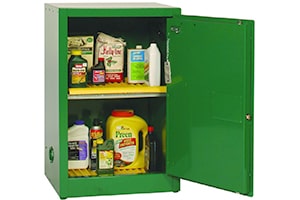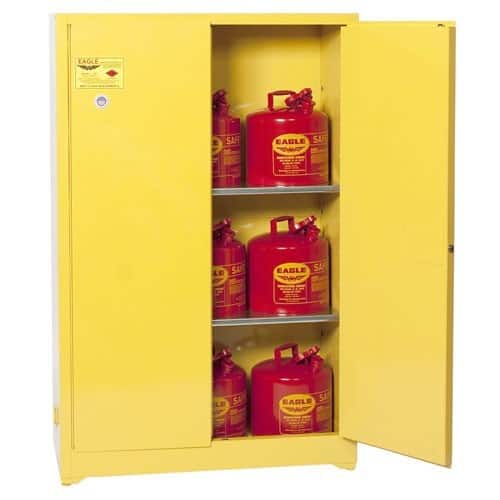When storing hazardous chemicals, ensuring safety is paramount. Corrosives storage cabinets are essential for safely housing chemicals that can cause serious harm if not properly contained. Choosing the right materials for these cabinets can make all the difference in maintaining a safe environment.
In this article, we’ll explore the key considerations when selecting materials for corrosives storage cabinets. We’ll cover the importance of chemical compatibility, material durability, and regulatory compliance. By the end, you’ll have a clear understanding of how to choose the best materials for your needs.
Understanding Chemical Compatibility
Why Chemical Compatibility Matters
Chemical compatibility is crucial when choosing materials for corrosives storage cabinets. Different chemicals can react with certain materials, leading to dangerous situations, including leaks, spills, or even explosions. Ensuring that the materials used in your storage cabinets can withstand the chemicals they will store is the first step to maintaining safety.

Common Materials and Their Compatibility
Steel
Steel is a popular choice for storage cabinets due to its durability and strength, making it ideal for protecting valuable items and tools. However, it is not resistant to all chemicals, particularly acids. If steel is exposed to harsh chemicals, it can corrode and weaken over time, compromising the integrity and safety of the storage cabinets. To mitigate this risk, it’s important to apply protective coatings or consider alternative materials for environments where exposure to corrosive substances is likely. Regular maintenance and inspections can also help extend the lifespan of steel cabinets in such conditions.
Polyethylene
Polyethylene is highly resistant to many corrosive chemicals, making it a safer choice for storing acids and bases. This material is often favored in laboratories and industrial settings due to its robustness against chemical attacks. Although it is less durable than steel in terms of physical strength, polyethylene offers excellent chemical resistance, significantly reducing the risk of hazardous reactions. Its lightweight nature and cost-effectiveness further make it an attractive option for a variety of applications where chemical stability is crucial.
Polypropylene
Similar to polyethylene, polypropylene offers good chemical resistance but with slightly better durability. It is often used for storing a variety of corrosive substances, including acids and alkalis, making it a reliable choice for many applications. Its versatility extends to packaging, automotive parts, and even textiles, showcasing its broad utility in different industries. Additionally, polypropylene is known for its resistance to fatigue, low moisture absorption, and ability to maintain its shape after bending or twisting, further enhancing its appeal in demanding environments.
Material Durability and Strength
Evaluating Durability Needs
The durability of the materials used in corrosives storage cabinets is critical. The cabinets need to withstand not only the chemicals stored within but also the daily wear and tear of use. Here’s how different materials measure up:
Steel
Steel is incredibly durable and can handle significant weight and impact. However, its vulnerability to certain chemicals can compromise its longevity.
Polyethylene and Polypropylene
Both polyethylene and polypropylene are less durable than steel in terms of physical strength but offer superior resistance to chemical corrosion. They are less likely to degrade when exposed to harsh chemicals, making them a safer choice for specific applications.
Balancing Durability and Chemical Resistance
Choosing between durability and chemical resistance often depends on the specific chemicals you need to store. For example, if you store highly corrosive acids, opting for polyethylene or polypropylene might be wiser despite their lower physical strength. Conversely, for less reactive chemicals, steel might suffice.
Regulatory Compliance
Importance of Following Regulations
Compliance with safety regulations is non-negotiable when dealing with hazardous chemicals. Regulatory bodies such as OSHA (Occupational Safety and Health Administration) and EPA (Environmental Protection Agency) have strict guidelines for storing hazardous materials. Ensuring your storage cabinets meet these standards is vital for both safety and legal reasons.
Key Regulations to Consider
OSHA Regulations
OSHA has specific requirements for the storage of hazardous chemicals, including the type of materials used in storage cabinets. These regulations are designed to ensure safety and minimize risks in the workplace. They mandate that cabinets must be constructed to limit the risk of fire and corrosion, which involves using materials that are fire-resistant and resistant to chemical Corrosivethey remain in good condition and continue to provide the necessary protection against potential hazards.
EPA Regulations
The EPA also has comprehensive guidelines for chemical storage, particularly concerning spill prevention and environmental protection. These guidelines include specific requirements for proper labeling, containment systems, and regular inspections to prevent leaks and spills. Ensuring your storage facilities adhere to these standards not only helps protect the environment but also enhances workplace safety and compliance with federal regulations.e solutions comply with EPA standards helps protect both your workplace and the environment.

Practical Tips for Selecting the Right Materials
Assessing Your Storage Needs
Before choosing materials, assess the types of chemicals you will store and the conditions they will be stored under. Consider factors such as temperature, humidity, and potential exposure to other chemicals.
Consulting with Experts
Consulting with experts in chemical storage can provide valuable insights into the best materials for your specific needs. They can help you navigate the complexities of chemical compatibility and regulatory compliance.
Regular Maintenance and Inspection
No matter what materials you choose, regular maintenance and inspection of your storage cabinets are essential. Look for signs of wear, corrosion, or damage, and address any issues promptly to ensure ongoing safety.
Conclusion
Choosing the right materials for corrosive storage cabinets is a critical decision that impacts the safety and efficiency of your chemical storage. By considering chemical compatibility, material durability, and regulatory compliance, you can make an informed choice that protects both your workplace and the environment.
Investing in the right materials not only ensures safety but also longevity and reliability in your storage solutions. With the knowledge gained from this article, you are well-equipped to select the best materials for your corrosive storage cabinets.
Shop at Absorbents Online
Ensuring the safety and compliance of your chemical storage solutions is paramount. At Absorbents Online, we offer a comprehensive range of high-quality and certified storage cabinets suitable for corrosive and hazardous materials. Our products are designed to meet strict OSHA and EPA regulations, providing you with peace of mind and reliable protection. Visit our website today to explore our extensive selection and find the perfect storage solutions tailored to your specific needs. Don’t compromise on safety—shop with Absorbents Online for top-notch quality and service.